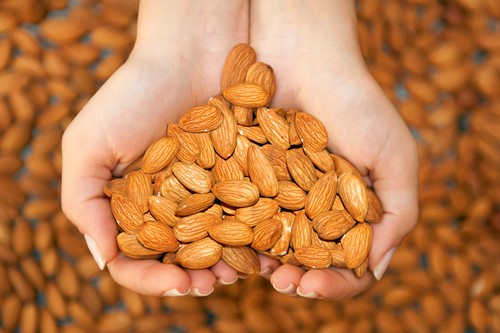Natural Almonds
Almonds are rich in vitamin E, monosaturated fats and fiber. They also include minerals such as calcium, phosphorus, and magnesium. One serving is considered an ounce or about 23 almonds. One serving is about 65 calories with 6 grams of protein, 14 grams of fat, 6 grams of carbs and 3 grams of fiber. Controlled trials have shown that general nut intake can decrease inflammation, promote healthy blood vessels, and reduce insulin resistance. They have been associated with less weight gain and a lower risk of obesity, possibly because the fat and fiber content help to improve feelings of being full.

In 2003 the U.S. Food and Drug Administration approved manufacturers to state on food labels that eating 1.5 ounces per day of most nuts as part of a diet low in saturated fat and cholesterol may reduce the risk of heart disease. There are different ways to eat almonds, so we are going to now look at blanched almonds and almonds that are roasted. Does this change anything about them?
Blanched Almonds
Blanching almonds is done by removing the skin. You can buy them blanched or do it yourself by doing the following. First place them in boiling water for no longer than 1 minute, drain them in a colander and rinse them in cold water. Once this is done you can then remove the skins. And now they are blanched. Blanching is done to change the taste of the almond and the color of it. So, what does this do to them nutritionally? Blanching seems to have very little effect on either calorie or fiber content. This also can be said for its protein content. But its fat content is reduced by a gram per serving size.
Roasted Almonds
Nuts are roasted to change their texture and taste. There isn’t a big difference in nutrition content. But note: One ounce of raw almonds contains 161 calories and 14 grams of fat, but the same number of roasted almonds contains 167 calories and 15 grams of fat. Nuts lose moisture during the roasting process. So, a roasted almond will weigh less than a raw one. And this explains why the fat content is slightly higher in the roasted ones. It is possible also to lose some of the nutrients that almonds have when roasted. When a nut is roasted at a high heat it is likely that you will affect the micronutrient value. If the nut is roasted at a low to medium heat, then you would be less likely to have this loss. I don’t know about you but when I’m at the grocer buying nuts I see “roasted” on the label not High, Medium or Low Roasted. So, you would really have to do some digging to find out how they were roasted. Unless, of course you’re buying them at the State Fair along with fried Snickers bars and then all bets are off. LOL!
In summary. Almonds are a great choice to snack on. But remember to watch your serving sizes. Hitting the nut bowl at home several times a day and grabbing a handful at a time isn’t the smartest thing to do. I know from personal experience. Eating blanched and roasted almonds does not have a big effect on them, unless. Unless you are really counting your macronutrients and micronutrients. And in that case, it is probably safer to go RAW!